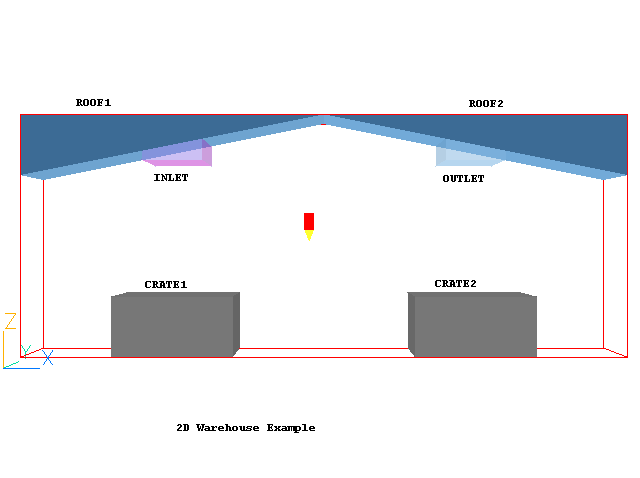
wherein:
This workshop example shows demonstrates the use of the ANGLED-IN and ANGLED-OUT objects.
The example is a 2-dimensional section of a warehouse. The fluid is air and the flow is turbulent and isothermal.
The geometry is to be as shown in the figure below, with the vertical dimension 4m and the horizontal dimension 10m :

wherein:
First activate the PHOENICS Satellite module in VR-Editor mode by either:
If you are uncertain of, or wish to change, your working directory, click on 'Options', 'Change working directory'.
When the Editor starts execution, what it shows on the screen will depend on what happens to be in your working directory. You can disregard this.
In order to make a fresh start;
You are now ready to begin.
Click on 'Main Menu' and set '2D Warehouse Example' as the Title.
Click on 'Geometry'.
Change the X-Domain Size to 10.0 m and the Z-Domain Size to 4.0m.
Click 'OK' to close the Grid mesh settings dialog.
Click on 'Models'.
Leave the 'solution for velocities and pressure' ON, and Energy Equation OFF. The default turbulence model, Chen-Kim KE (KECHEN), can also be left active.
Click on 'Top Menu'.
Create the internal surfaces of the domain:
Click on 'Domain Faces'.
Set 'Wall' to 'Yes' for the Xmin, Xmax and Zmin faces.
Click on 'OK' to close the Domain Faces Dialogue Box, and 'OK' again to close the reminder to set / check boundary conditions. The default conditions are fine.
Click on 'OK' to exit the Main Menu.
Click 'Reset' on the Movement control panel, then 'Fit to window' to re-scale the view to fit the geometry.
Click on 'Top menu', then on 'OK' to exit the Main Menu.
The domain no longer fits the screen. To resize the view so that it does fit, click on the pull-down next to the 'R' icon on the toolbar then 'Fit to Window'.
Create the objects making up the scene
Click on the 'Object Management' button (O on the toolbar or
on the hand set). This will display a list of objects, initially the three domain-face PLATE objects.
Select all the PLATE objects, then right-click and 'Hide objects'. This will prevent the plates from obscuring the inside of the domain.
Create the ROOF1 object:
In the Object management dialog, click on 'Object', 'New', 'New Object', 'Blockage'.
Change name to ROOF1
Click on 'Size' and set SIZE of object as:
Xsize: 5.0
Ysize: tick 'To end'
Zsize: 1.0
Click on 'Place' and set Position of object as:
Xpos: 0.0
Ypos: 0.0
Zpos: tick 'At end'
Click on 'General'.
Click on 'Shape'. Click on Geometry and select public/shapes/wedge' as the geometry file, then click 'Open'. The new shape is not aligned correctly. Click on 'Options' then 'Rotation options'. The 'Rotate object face' entry sets the orientation of the shape with its bounding box. There are 24 possible orientations. Keep changing the orientation number until you find the one which makes the shape lie correctly (it is number 12). An alternative way to do the same job is to repeatedly click on the 'Rotate object up/down' buttons
on the handset (if it is visible).
Click on 'OK' to exit the Rotation Options menu,
and on 'OK' to close the Object Specification Dialogue Box. ROOF1 will now appear in the Object Management list of objects.
Create the ROOF2 object:
Select the ROOF1 object, then click 'Object' - 'Copy object' and 'OK' to allow the copy.
The copied object will now be highlighted in the Object Management Dialog. Double-click it to open the Object attributes dialog.
Change name to ROOF2.
Click on 'Place' and set the X position to 'At end'.
Click on 'Options' then 'Rotation options'. Change the rotation number (Rotate object face) until the orientation is correct (16 in this case).
Click on 'OK' to return to the Object Specification Dialogue Box, and on 'OK' to close the Object Dialogue Box.
Create the INLET object:
Click on 'Object', 'New' 'New Object', 'Angled-in'.
Change name to INLET .
Click on 'Size' and set SIZE of object as:
Xsize: 1.0
Ysize: 'To end'
Zsize: 0.75
Click on 'Place' and set Position of object as:
Xpos: 2.0
Ypos: 0.0
Zpos: 'At end'
Click on 'General'.
Note that the shape and size of the angled-in object do not really matter - what matters is the size and shape of the area of intersection between it and any blockage which it overlaps. In this case the active inlet area will be the outer surface of the ROOF1 wedge segment which lies within INLET.
Click on 'Attributes' to set the inlet condition.
For 'Method' select 'Vol. flow rate'. Enter 2.0 m3/s for the volumetric flow rate and click 'OK' to close the Attributes dialog.
Click on 'OK' to close the Object Specification Dialogue Box.
Create the OUTLET object:
Click on 'Object', 'New', 'New Object', 'Angled-out'.
Change name to OUTLET.
Click on 'Size' and set SIZE of object as:
Xsize: 1.0
Ysize: 'To end'
Zsize: 0.75
Click on 'Place' and set Position of object as:
Xpos: 7.0
Ypos: 0.0
Zpos: 'At end'
Click on 'General'.
Note that the shape and size of the angled-out object do not really matter - what matters is the size and shape of the area of intersection between it and any blockage which it overlaps. In this case the active outlet area will be the outer surface of the ROOF2 wedge segment which lies within OUTLET.
Click on 'OK' to close the Object Specification Dialogue Box.
Create the CRATE1 object:
Click on 'Object', 'New' and New Object', 'Blockage'.
Change name to CRATE1.
Click on 'Size' and set SIZE of object as:
Xsize: 2.0
Ysize: 'To end'
Zsize: 1.0
Click on 'Place' and set Position of object as:
Xpos: 1.5
Ypos: 0.0
Zpos: 0.0
Click on 'General'.
Click on 'OK' to close the Object Specification Dialogue Box.
Create the CRATE2 object:
Select the CRATE1 object, then click 'Object' - 'Copy object' and 'OK' to allow the copy.
The copied object will now be highlighted in the Object Management Dialog. Double-click it to open the Object attributes dialog.
Change name to CRATE2.
Click on 'Place' and set the X position to 6.5m.
Set the grid:
Click on the 'Mesh toggle' button. The default mesh will appear on the screen.
The orange lines are region lines,and denote the edges of the bounding boxes of each object. The blue lines are ordinary grid lines introduced by the auto-mesher.
Click anywhere on the image, and the 'Gridmesh settings' dialog box will appear.
The grid in all three directions is set to 'Auto'. This gives 62 cells in X and 50 in Z, and 1 cell in Y. This will suffice for the tutorial, though it might not be enough for a 'real' calculation. Click on 'OK' to close the dialog box. Click on 'Mesh toggle' again to turn off the mesh display.
Set the remaining solution-control parameters:
Click on 'Main Menu' and then on 'Numerics'.
The default number of iterations is 1000. This is more than enough to test if a model is set up correctly, but is rarely enough to obtain a converged solution.
Reset the total number of iterations to 750.
Click on 'Top menu' to return to the top menu.
Click on 'OK' to exit the Main Menu.
Setting the Probe Location
Before running the solver,it is a good idea to place the probe in a suitable place to monitor the convergence of the solution. Too close to an inlet, and the value will settle down very quickly before the rest of the solution. Placed in a recirculation zone, it may still show traces of change even though the bulk solution is converged. In this case, somewhere in the middle of the domain is fine.
Click on the probe icon
on the toolbar or double-click the probe itself, and move the probe to X=5.0, Y=0.5, Z=2.0.
In the PHOENICS-VR environment, click on 'Run', 'Solver'(Earth), and click on 'OK' to confirm running Earth.
In the PHOENICS-VR environment, click on 'Run', 'Post processor',then GUI Post processor (VR Viewer) . Click 'OK' on the file names dialog to accept the default files.
To view:
To select the plotting variable:
To change the direction of the plotting plane, set the slice direction to X, Y or Z ![]()
To change the position of the plotting plane, move the probe using the probe position buttons
 .
.
Alternatively, click on the probe icon
![]() on the toolbar or double-click the probe itself to bring up the Probe
Location dialog.
on the toolbar or double-click the probe itself to bring up the Probe
Location dialog.
A typical vector plot from this case is:
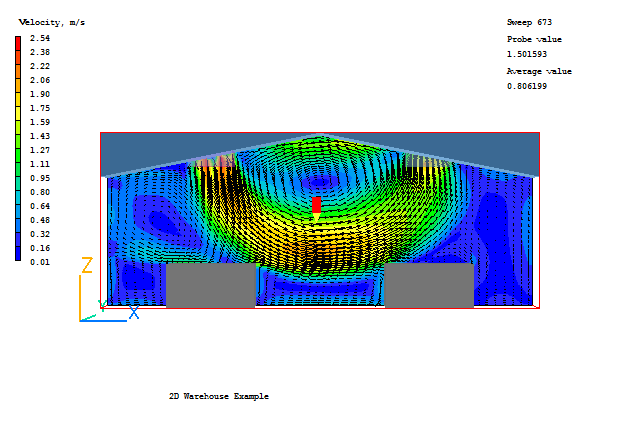
A typical pressure contour plot is:
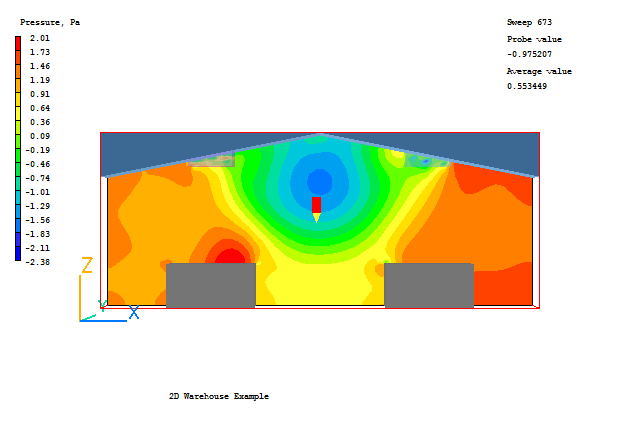
It is very important to know whether the inflows and outflows of mass and energy are in balance. If they are, it is a good sign that the solution is convergent. If they are not, the solution is definitely not converged. For further information on the assessment of Convergence, see the lecture Convergence monitoring and control.
Open the Object Management dialog, and right-click on the Domain entry. From the context menu select 'Show nett sources'.
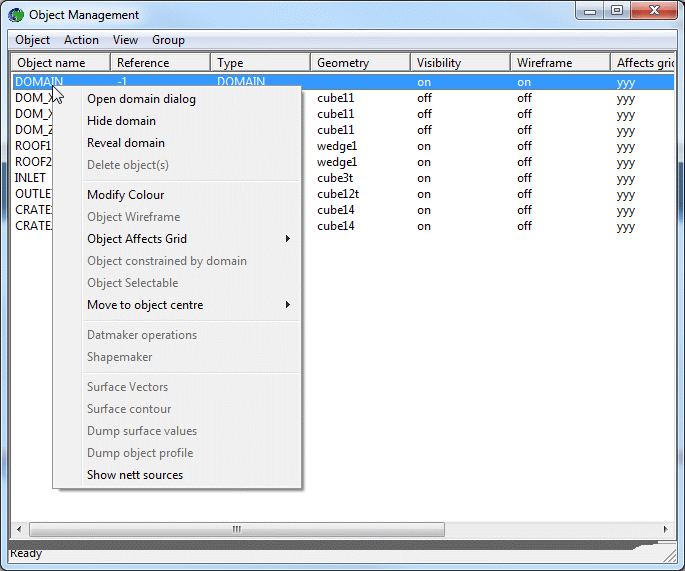
This will display the sources and sinks of all variables.
The section showing 'Nett source of R1 at...' shows the mass source in kg/s at each inlet and outlet.
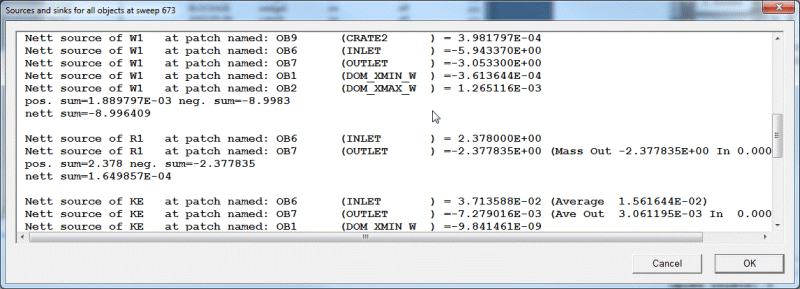
Positive values are inflows,negative values are outflows. The 'nett sum' at the end of the section should be close to zero, as all the mass entering must leave.
These balances can also be checked by inspecting the RESULT file. This contains an echo of the inputs, a selection of the solution and the source balances. Click on 'File', 'Open file for editing', then 'Result'. Scroll down the file until you reach the section headed 'Sources and sinks'.
In the PHOENICS-VR environment, click on 'Save as a case', make a new folder called 'ANG-IN ' (e.g.) and save as 'CASE1' (e.g.). Return to the VR-Editor by clicking 'Run' - 'Pre-processor' - 'GUI Pre-processor'.
In the run just made, the inflow condition was set to 2.0m3/s. The flow enters the domain normal to the surface of the underlying blockage. (A second tutorial investigates this further). Another option is to set the cartesian components of the inflow vector.
Let us assume we want to see what happens if the inflow is directed towards the bottom-left instead of being normal to the surface. We want the velocity to be 2.0m/s, directed at 45º to left of the vertical. This means that the vertical (Z) component should be -1.414 and the horizontal (X) component also -1.414. (2*cos(45) or sin(45)).
Double-click on the INLET object to bring up its Object Specification dialog. Click on 'Attributes'. Change the 'Method' from 'Vol. flow rate' to 'Velocities'. Enter -1.414 for both the X and Z direction components. Click 'OK' to close the Attributes dialog, then again to close the Object Specification dialog.
Click on 'Run' then 'Solver' to run the solver again.
Enter the Viewer and inspect the solution.
Check the mass balance again, either by opening the Result file, or from the Object Management dialog in the Viewer as explained above.
The flow is slightly different, as seen in the vector field:
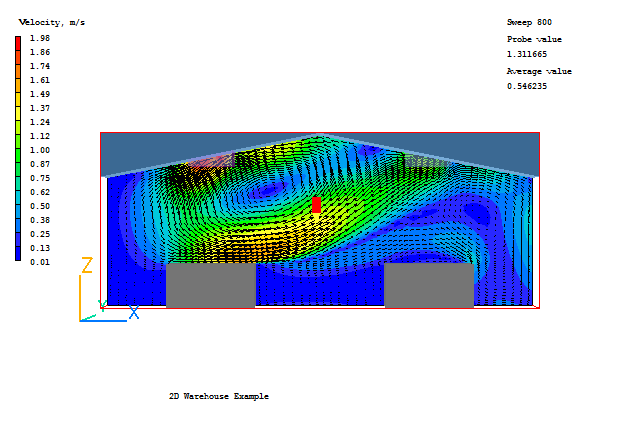
and pressure field:
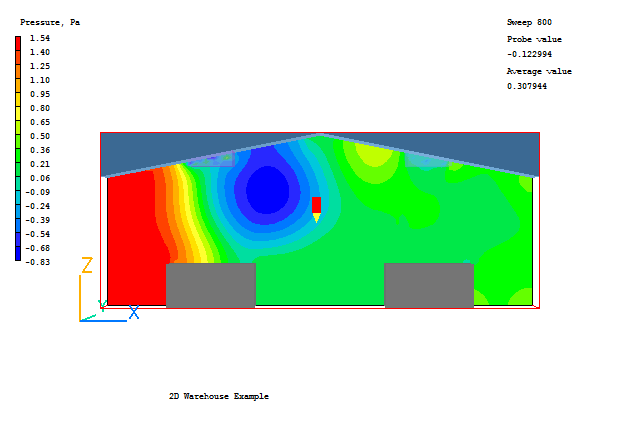
Save the new results into the 'ANG-IN' folder as 'CASE2'.